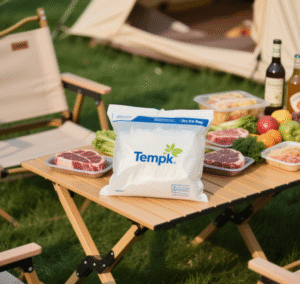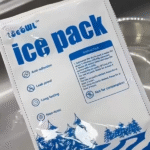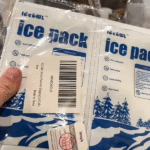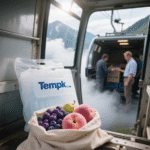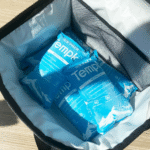Craving ice‑cold smoothies on day three of your trek? Dry ice pack camping lets you carry –78 °C power into the wild, cutting cooler weight and drip mess while locking in freshness. This guide delivers proven load equations, 2025 gear upgrades, and fool‑proof safety so you can feast off‑grid without worry.
-
How many kilos of dry ice protect food for one, two, or three nights?
-
Which 2025 coolers and liners slow sublimation on scorching trails?
-
When do reusable gel packs beat dry ice—and how can you blend both?
-
What hands‑on tricks prevent frostbite, CO₂ buildup, and food freeze‑burn?
-
Which tech trends are making back‑country cold chains lighter and greener?
How Much Dry Ice Does Your Adventure Need?
Quick rule: Pack dry ice equal to half your frozen payload for a single night, match payload weight for a weekend, and go 1.4× for a 72‑hour expedition. Place slabs on top; cold air sinks and blankets contents.
| Frozen Food (kg) | Dry Ice (kg) 1 Night | Dry Ice (kg) 2 Nights | Dry Ice (kg) 3 Nights |
|---|---|---|---|
| 1 | 0.5 | 1 | 1.4 |
| 3 | 1.5 | 3 | 4.2 |
| 5 | 2.5 | 5 | 7 |
Trail tactic: Pre‑cool your empty box in a home freezer for four hours; expect roughly 15 % longer freeze retention.
Why Choose Dry Ice Over Gel Packs on Long Trips?
| Criterion | Gel Packs | Dry Ice | Field Impact |
|---|---|---|---|
| Temp Range | 0–8 °C | –78 °C | Dry ice keeps steaks rock‑solid |
| Weight/Day | ≈ 0.3 kg/kg food | ≈ 0.5 kg/kg food | Slightly heavier, far colder |
| Mess Factor | Melt water | No liquid | Dryer gear and tents |
| Safety Gear | None | Gloves, vent | Plan handling time |
| Reusability | Yes | No | Balance waste vs convenience |
Gel is perfect for salads and beverages, but dry ice wins for ice cream, fish, or game meat destined for the grill.
2025‑Ready Cooler Checklist for Dry Ice Pack Camping
-
R‑Value ≥ 4.5 m² K/W – aerogel or VIP panels cut sublimation.
-
Smart‑Vent Patch – releases CO₂ while blocking heat.
-
Fold‑Flat Liner – saves cargo space on the hike out.
-
NFC Temp Logger – check core temps without opening the lid.
-
Weight < 1 kg per 12 L – keeps packs manageable on steep ascents.
Gear Spotlight: Ultralight AeroFlex™ 15 L
-
25 % thinner walls than traditional rotomolded coolers
-
Integrated vent dial prevents pressure spikes at altitude
-
Fits airline carry‑on rules with ≤ 2.5 kg dry ice
Packing Method: Layer Like a Pro
-
Reflective liner against cooler walls.
-
Frozen entrées at the bottom.
-
Corrugated spacer—avoids freeze‑burn.
-
Dry ice slabs on top, wrapped in waxed paper.
-
Fill voids with spare clothes to cut air gaps.
Real‑world win: A three‑day desert music‑fest crew kept 6 kg frozen burritos solid by using a 20 L smart‑vent cooler with 8 kg dry ice—mid‑day highs hit 40 °C but temps inside stayed at –32 °C.
Safe Handling & Eco Disposal in the Back‑Country
-
Insulated gloves for every transfer—skin contact can frostbite in seconds.
-
Store the cooler outside your tent to avoid CO₂ accumulation.
-
Let leftover dry ice sublimate on a flat rock far from vegetation; never bury.
-
Combine two room‑temperature gel packs under produce to shield it from the –78 °C zone.
Emerging Trends Shaping Dry Ice Pack Camping
By late‑2024, breweries began capturing exhaust CO₂ to produce carbon‑negative dry ice, trimming footprint by 30 %. Start‑ups now offer plant‑based aerogel liners that compost within six months. NFC tags have evolved into bi‑directional loggers, letting campers upload temperature histories for warranty claims—proof that gear worked as promised.
Analysts forecast a 9 % CAGR for hybrid coolant kits (gel + micro dry ice slabs) through 2028 as eco‑minded trekkers seek lighter, lower‑waste options.
FAQ
Can I fly with dry ice before hitting the trail?
Yes—up to 2.5 kg per cooler is airline‑approved with a UN 1845 label and vented lid.
How do I stop veggies from freezing next to dry ice?
Buffer them with a gel pack layer or insulate in a fabric pouch under the dry‑ice shelf.
Is dry ice harmful to wildlife?
Only if left in a sealed space. Let it evaporate fully in open air, then pack out all liners.
Summary & Next Steps
Mastering dry ice pack camping is about right‑sizing the load, venting CO₂, and using high‑R insulation. Follow the 0.5‑to‑1.4× load chart, layer ice above your food, and enjoy gourmet frozen meals for up to three nights—no soggy cooler blues.
Action plan:
-
Run our Cooler‑Sizer tool for the perfect volume.
-
Order the Dry‑Ice Starter Kit with NFC logger.
-
Share your first adventure story for a 10 % refill voucher.
About Tempk
We build recyclable thermal gear that keeps explorers fuelled and safe. Our latest AeroFlex™ camping liners weigh 20 % less than foam yet hold –30 °C for 60 h. Field‑tested from Yukon canoe trips to Saharan bikepacking, they fold flat for the journey home.
Ready for frosty freedom? Book a free consult.






